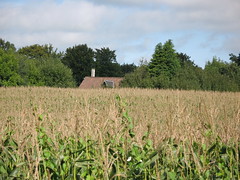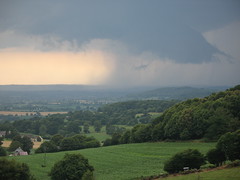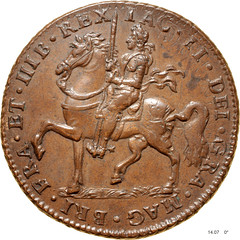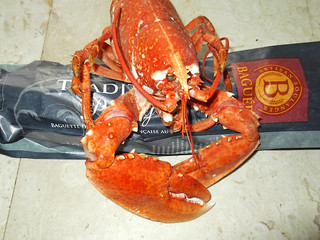
PREV ARTICLE
NEXT ARTICLE
FULL ISSUE
PREV FULL ISSUE
PAUL WITHERS ON NUMISMATIC WRITING
Paul Withers submitted this wonderful travelogue and treatise on writing numismatic books. Thanks! This is something to be studied by all
numismatic authors new and old. -Editor
Some Thoughts On Numismatic Writing When I tell friends that we are going to France to work, they smile knowingly, as if they are certain that we are to about to partake in an orgy of reckless indulgence in food and wine in a warm, pleasant climate. This is only partially true, but if you are not familiar with Europe and are interested in food, wine, coins, publishing and writing, and a little advice for those contemplating writing, then read on… Imagine 8am on a typical Thursday morning in Wales a couple of months back: after a shower and breakfast it was time to go to the fishmonger who visits our village once a week that day. At 8.30 it was time to start work, and the day began with three fairly lengthy incoming ’phone calls, one after the other, and those calls resulted in two outgoing calls, then there were several e-mail enquiries about books to be answered, so it was well gone eleven before we could get down to the serious business of writing, the scheduled task for the day. Don’t get me wrong, the calls and e-mails were not unwelcome, indeed two of the calls were from people who have become good friends through numismatics; it’s simply that without interruptions the progress of a book could be expedited much more rapidly, and sometimes this is necessary. This is why this year we have visited our French cottage twice, the first time in May to tie up the loose ends of the Anglo-Gallic book. Books do not spring unbidden into the author’s mind, nor are they written instantly by the computer. Those who have read my previous musings may recall that our Anglo-Gallic book has taken twelve years to research and write. By then we had each read and re-read the book umpteen times, and each of us had checked and double-checked the work of the other two. Why do we spend such a long time on a book, and make so many checks ? In pre-internet days a friend rang asking whether we had seen X’s new book. X was a mutual acquaintance who wrote on a subject that interested us both. I had to admit that I had not seen it. I heard a chuckle and when I’d said that I would take a quick look, I was told that one was in the post to me. It arrived the following morning. The book was accompanied by my friend’s list of comments and errors, which was almost as large as the book. I read the chapters that related to my interest and was amazed at the many errors and omissions. I forwarded the text and my corrections to a friend in the USA. I got his immediate response on the American-related section. I forwarded those and my own to the person who had sent the book to me and they were relayed to the author. Alas, I did not keep the book, for it would now be an extremely rare numismatic book because on seeing the comments and the corrections necessary, the author had the entire printing pulped ! This was an important lesson to me and ever since then I have been ultra-careful as to what I write, and pre-publication manuscripts of books are sent to friends for their honest opinions. In the first instance they go to non-numismatists, who ask questions like “What’s the difference between feudal coins and regal coins* ?” Such people are treasures, not only because they do the job time after time, but because they make you aware that the world is full of real people who know coins through spending them, not collecting them. Then others took over, some correcting split infinitives, not realizing that for a Welshman, the split infinitive is a tool of poetic expression, whilst others corrected spelling and grammatical errors, added commas and changed my commas for semi-colons, or colons where necessary. Then Duncan stepped in to give the book the once, or even thrice over. Some people might say that Duncan is pernickety, perhaps because aside from his numismatic interests, his day job is writing and up-dating the operating manuals for the atomic power station where he works, so you listen very carefully to what he says, or your book could become the blueprint for a numismatic Chernobyl, or if you think that such things are only the result of Soviet Russian failings, remember Three Mile Island, if you are old enough ! 

We went to France for peace, quiet and isolation, to get down to the last bit of polishing which included designing the front cover and mundane tasks such as working out where the tab settings should be, and then making sure that they, and other things were consistent throughout the book. Of such details are the best books made. That process took two whole weeks. Each page is carefully composed and laid out. My day job 40-odd years ago was teaching what we then termed “under-functioning” children, who were sometimes very bright indeed and included some of whom were suffering from what is now described as Asperger’s syndrome. Each part of the learning process was split into small discrete steps. This was good training for the writing of numismatic books because laying out things so that they cannot be misunderstood is essential, and there is, I am sure, a touch of Asperger’s in every collector. In scientific subjects, and numismatics is a science, the anal retentive wins every time ! It is tempting to be miserly when writing a book. The internal accountant wants you want to cram as much onto a page as possible, this is because some years later, in another training, paper and printing plates were costly. However, time has taught me that the appearance of a book is almost as important as its content. Having a book that looks good can make all the difference between selling a hundred, or just a dozen, and a little white space can result in a dramatic difference to the overall appearance of a book and its user-friendliness and clarity. When that was done, we took the book back to Wales and within a week or three of final dotting of t's and crossing i's, we packed it off to a museum curator whose speciality is English hammered coins; a retired, but not inactive, French museum curator whose familiarity with French coins is unrivalled; a specialist dealer in European hammered coins and one or two others besides. These folk were chosen, not only because they are clever numismatists, but because some of them have experience editing books and journals. Three of them immediately came up with valuable suggestions. One knew someone who probably had a photograph the book needed and sent us that person’s e-mail address. We e-mailed him and the photograph and permission to use it reached us electronically within two hours. Another sent us information about an article that we had overlooked that had interesting and relevant information. We are now eagerly awaiting more comments, and for the retired French curator to write a French preface. Now books are not written in isolation, and as well as the Anglo-Gallic book being more or less finished, our contribution to Spink’s Coins of Scotland, Ireland and the Islands, for which we did the typesetting and much of the photography, was more or less finished. So, it was on with the next project, but which one ? [For those who want more details, or to reserve of one or both of forthcoming books, visit the Galata, and/or Spink websites: www.galata.co.uk and www.spink.com] For those who wonder what the above has to do with the price of fish, whilst we were in Ireland doing the photography for the Irish portion of Coins of Scotland, Ireland and the Islands two years ago (and yes, these things really do take that long), that visit to the Emerald Isle also provided the inspiration for our next writing and publishing project, a catalogue of Irish gunmoney. In the good old days, for most numismatic authors, the genesis of a book was the formation of a reference collection. A “reference” collection is one that has, as far as is known, a high degree of completeness, so that new specimens that turn up can be compared with those already in the collection. You know when it is time to publish when you examine a reasonably large collection that you have not seen before, and not more than 5% of the coins you see are new ! Two of our books: British Coin-Weights and British Copper Tokens, 1811-1820, began that way. However, these days my life is too near to its end to contemplate forming a new significant collection, even if we could afford to do so. Whilst in Ireland we saw what must be the best collection of Irish gunmoney in private hands, which we photographed to act as a reference collection. Its owner began to form the collection over a quarter of a century ago, back in the days when there was plenty of such material around. The collection is an academic one, i.e, if the piece was from a different die, the owner kept it, regardless of its state of preservation. He also kept examples of die duplicates when they showed the development of die cracks. The object of the exercise was to collect every possible die and combination, regardless of condition, though wherever possible the owner bought the best possible piece available, and made many improvements over the quarter-century. To my mind, this collection, approaching 1500 coins, in brass, pewter and silver, had the possibility of revealing hitherto well-kept secrets, because whilst people have been looking at these coins for three centuries, no one has as yet made a rigorous, coin-by-coin photographic survey and record of the series for a die study.
Anyone not living in Wales might have concluded that the month of June, 2015 was the beginning of a hot summer. Indeed for those in the south of England things were good indeed. Indeed, in anticipation of increases of temperature arriving from the south, I had had a close haircut. Then the media announced that the 2nd of July was the hottest July day since records began. However, in our little village in Wales, it just reached a humid and sticky 22°C, and to add insult to injury it rained ! The next day there was prolonged rain and the temperature only just reached 17°C, so much for a blazing June and a hot British summer. We decided to get off as quickly as possible. Now, normally there is plenty of space on the ferry from Portsmouth to Caen outside of school holidays. However, French ferry workers were (and still are) striking, and lorries using the Channel Tunnel found themselves unable to use that route because burning tyres were placed on the access roads, and thousands of African immigrants were openly breaking into lorries in an attempt to become stowaways. So, we took the last two berths available. So, at the beginning of July we found ourselves en route for France, clutching the literature and our laptop computers. For those unfamiliar with gunmoney, it is comes in four denominations: crowns, halfcrowns, shillings and sixpences, and of those the halfcrowns and the shillings come in two sizes. They were struck bearing just two dates 1689 and 1690. The crowns and the small size halfcrowns were struck over large size halfcrowns and shillings respectively. The crowns were only struck dated 1690. Some pieces were also struck in silver because, it is said, officers, or perhaps it was gentlemen, would not accept the brass rubbish that the Stuart king, James II, who had already been ousted by the population of England, was trying to regain his throne through the support of the population of Ireland who were largely Roman catholic. What is interesting and attractive to some people is that all denominations apart from the crown were struck bearing the month they were issued, as well as the year. It is said that they were to be redeemed, month by month, for good silver money once James won back his rightful place as king. After our arrival in France we spent the first fortnight checking the work of the previous six months. This sort of thing is not really the most pleasurable part of writing or research, but it has to be done, and obviously accuracy has to be 100%. Furthermore, it is best done by two people working together. It can only done in short concentrated bursts. Any more and you become bad-tempered, tired and begin to lose patience and concentration, so breaks are essential. We fill them with activities such as : reading, writing, cooking, shopping, preparing food or eating. Other less pleasurable, but equally essential ways are: dusting, vacuum-cleaning, washing up and gardening. Of the distractions, the most pleasurable are cooking and eating and shopping for things that are novel and interesting. Prices in shops can vary considerably so we have learned to shop around for bargains. The French way of life is quite different from the British. The availability of some commodities, including vegetables can vary considerably. Twenty years ago, for example, if was impossible to buy parsnips in mainland Europe. Now, due to an influx of British immigrants into Normandy, they are available. I remember my Danish father-in-law’s reaction some 40 years ago when I confessed my love of this humble but delicious vegetable, which was not then available in Denmark. We had difficulty even in finding the Danish word for it. “Oh” said he, when he discovered what they were “we feed them to cows !” Initially the French reaction was much the same, but the parsnip has gained popularity right throughout Europe since the days when an enthusiastic au-pair took back to Germany a packet of seeds so that she could grow them there because none were available there. Most Brits imagine that ingredients for cooking are better in France than they are in the UK. However, as someone who regularly shops in both countries, I can say that vegetables in the UK in supermarkets are fresher, and are available in much greater variety, and that when you consider what is available in ethnic shops here in the UK, we Brits are indeed very lucky. However, in France vegetables in season are available and they become cheap, unlike in the UK where we get things all the year round and there is little apparent seasonal variation and hardly any variation in price.
Why do I tell you this ? Because in another half century, this may be the only place where this is recorded ! *Apparently the answer that regal coins were issued by kings, and feudal coins were issued by those feuding will not do ! To be continued… THE BOOK BAZARREWayne Homren, Editor The Numismatic Bibliomania Society is a non-profit organization promoting numismatic literature. See our web site at coinbooks.org. To submit items for publication in The E-Sylum, write to the Editor at this address: whomren@gmail.com To subscribe go to: https://my.binhost.com/lists/listinfo/esylum All Rights Reserved. NBS Home Page Contact the NBS webmaster 
|

